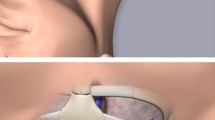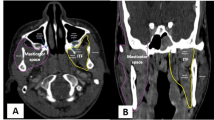Abstract
Purpose
The mastoid emissary vein (MEV) is a small venous channel connecting the intracranial and extracranial venous systems. Most current knowledge about the MEV has been obtained through cadaver studies. This study aimed to explore the MEV in vivo, using magnetic resonance imaging (MRI).
Methods
Ninety-six patients were enrolled in this study. The initial examinations used the conventional MRI sequences; contrast examinations were performed using thin-sliced sections.
Results
The MEVs were identified bilaterally in 59.3 % of the 96 patients and unilaterally in 29.2 %. The original site, size, and intraosseous course of the MEVs were highly variable. On coronal images, the MEVs originated from a variable height on the posterior wall of the sigmoid sinus, most frequently from the lower third of the wall. Intraosseous MEV courses were classified as straight, curved, or tortuous, with the straight type occurring most frequently. The MEVs were dominant on the right side in 51.8 % of cases and on the left side in 24.7 % of cases. Two patients had two MEVs on the same side. Furthermore, on eight sides (5.6 %), the diploic venous channel was found to communicate with the MEV.
Conclusions
The MEV is a structure with diverse morphologies and right-sided dominancy. MEVs should be evaluated before performing surgical and endovascular procedures around the suboccipital region.







Similar content being viewed by others
References
Braun JP, Tournade A (1977) Venous drainage in the craniocervical region. Neuroradiology 31:155–158
Chauhan NS, Sharma YP, Bhagra T, Sud B (2011) Persistence of multiple emissary veins of posterior fossa with unusual origin of left petrosquamosal sinus from mastoid emissary. Surg Radiol Anat 33:827–831
Cheatle A (1925) The mastoid emissary vein and its surgical importance. Proc R Soc Med 18:29–34
Chen Z, Feng H, Zhu G, Wu N, Lin J (2007) Anomalous intracranial venous drainage associated with basal ganglia calcification. AJNR Am J Neuroradiol 28:22–24
Hadeishi H, Yasui N, Suzuki A (1995) Mastoid canal and migrated bone wax in the sigmoid sinus: technical note. Neurosurgery 36:1220–1224
Kim LK, Ahn CS, Fernandes AE (2014) Mastoid emissary vein: anatomy and clinical relevance in plastic & reconstructive surgery. J Plast Reconstr Aesthet Surg 67:775–780
Lee SH, Kim SS, Sung KY, Nam EC (2013) Pulsatile tinnitus caused by a dilated mastoid emissary vein. J Korean Med Sci 28:628–630
Louis RG Jr, Loukas M, Wartmann CT, Tubbs RS, Apaydin N, Gupta AA, Spentzouris G, Ysique JR (2009) Clinical anatomy of the mastoid and occipital emissary veins in a large series. Surg Radiol Anat 31:139–144
Mortazavi MM, Tubbs RS, Riech S, Verma K, Shoja MM, Zurada A, Benninger B, Loukas M, Cohen Gadol AA (2012) Anatomy and pathology of the cranial emissary veins: a review with surgical implications. Neurosurgery 70:1312–1319
Pekcevik Y, Sahin H, Pekcevik R (2014) Prevalence of clinically important posterior fossa emissary veins on CT angiography. J Neurosci Rural Pract 5:135–138
Reis CV, Deshmukh V, Zabramski JM, Crusius M, Deshmukh P, Spetzler RF, Preul MC (2007) Anatomy of the mastoid emissary vein and venous system of the posterior neck region: neurosurgical implications. Neurosurgery 61(5 Suppl 2):193–201
Rivet DJ, Goddard JK 3rd, Rich KM, Derdeyn CP (2006) Percutaneous transvenous embolization of a dural arteriovenous fistula through a mastoid emissary vein. Technical note. J Neurosurg 105:636–639
San Millán Ruíz D, Gailloud P, Rüfenacht DA, Delavelle J, Henry F, Fasel JH (2002) The craniocervical venous system in relation to cerebral venous drainage. AJNR Am J Neuroradiol 23:1500–1508
Wysocki J (2008) The size of venous foramina and skull capacity in man and selected vertebrate species. Folia Morphol (Warsz) 67:98–103
Acknowledgments
This work was not supported by Grant funding.
Author information
Authors and Affiliations
Corresponding author
Ethics declarations
Conflict of interest
The authors have no conflicts of interest concerning the materials or methods used in this study, or the findings presented in this paper.
Rights and permissions
About this article
Cite this article
Tsutsumi, S., Ono, H. & Yasumoto, Y. The mastoid emissary vein: an anatomic study with magnetic resonance imaging. Surg Radiol Anat 39, 351–356 (2017). https://doi.org/10.1007/s00276-016-1733-7
Received:
Accepted:
Published:
Issue Date:
DOI: https://doi.org/10.1007/s00276-016-1733-7




